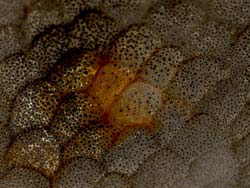New discovery: Plaice are spotted (on the inside)

The spotted skin of a plaice. <br>Photographs: Helen Nilsson Sköld<br><br>
Many species of animal have skin or fur with intricate pigmentation patterns, which they use for camouflage, communication, regulation of body heat and protection against the sun. A study conducted by researchers at the Department of Marine Ecology at the University of Gothenburg has found that several species of fish also have highly-coloured internal pigmentation.
Adapts to its surroundings
In a study published in Pigment Cell & Melanoma Research, marine biologist Helen Nilsson Sköld and her colleagues show that the number of internal pigment cells has a direct link to the degree of transparency of the fish. Transparent fish can change colour using their internal pigment cells, thus enhancing external skin pigmentation and their ability to adapt to the background colours of their surroundings.
Bewildering display of colour
Mysteriously, plaice also have a high number of internal pigment cells in, for instance, the ear and brain and around their internal organs. Plaice however are not particularly transparent. The internal pigment cells of this fish cannot be seen easily from the outside, which makes its internal display of colour somewhat bewildering.
Unknown functions
According to Helen Nilsson Sköld and her colleagues, the fact that less transparent fish also have this internal pigmentation indicates that the pigment cells may have other, as yet unknown, functions.
“We believe that the internal pigment cells either function as vessels for excess pigment or perhaps provide various forms of protection or contribute to the immune system. We hope to investigate this subject further,” says Helen Nilsson Sköld.
Contact:
Helen Nilsson Sköld, Department of Marine Ecology,
University of Gothenburg
+46 (0)706 827391.
helen.skold@marecol.gu.se
Media Contact
More Information:
http://www.gu.se/All latest news from the category: Life Sciences and Chemistry
Articles and reports from the Life Sciences and chemistry area deal with applied and basic research into modern biology, chemistry and human medicine.
Valuable information can be found on a range of life sciences fields including bacteriology, biochemistry, bionics, bioinformatics, biophysics, biotechnology, genetics, geobotany, human biology, marine biology, microbiology, molecular biology, cellular biology, zoology, bioinorganic chemistry, microchemistry and environmental chemistry.
Newest articles

Webb captures top of iconic horsehead nebula in unprecedented detail
NASA’s James Webb Space Telescope has captured the sharpest infrared images to date of a zoomed-in portion of one of the most distinctive objects in our skies, the Horsehead Nebula….

Cost-effective, high-capacity, and cyclable lithium-ion battery cathodes
Charge-recharge cycling of lithium-superrich iron oxide, a cost-effective and high-capacity cathode for new-generation lithium-ion batteries, can be greatly improved by doping with readily available mineral elements. The energy capacity and…

Novel genetic plant regeneration approach
…without the application of phytohormones. Researchers develop a novel plant regeneration approach by modulating the expression of genes that control plant cell differentiation. For ages now, plants have been the…





















